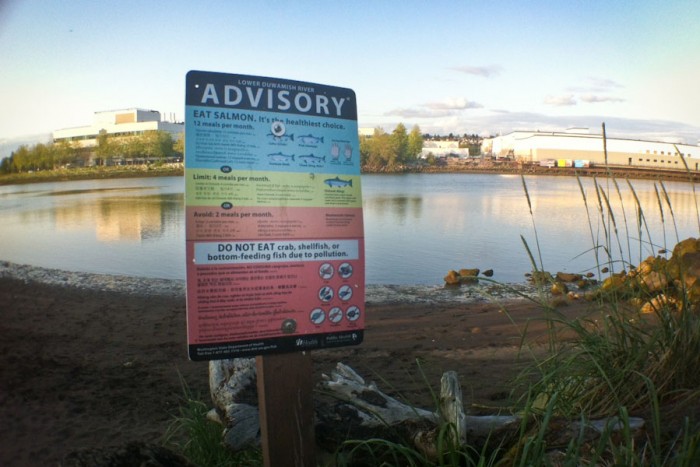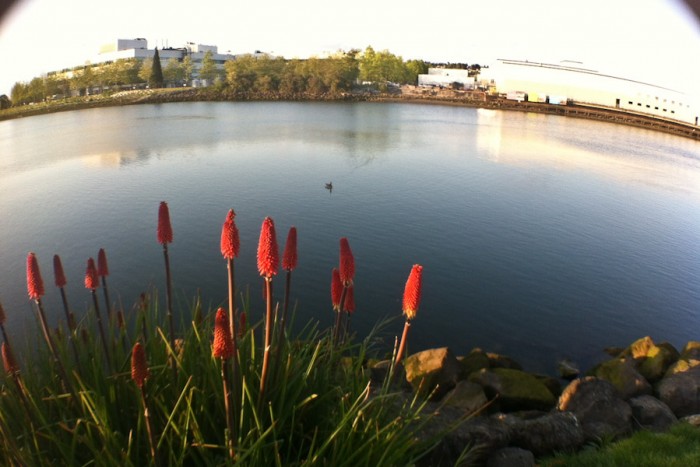
We Seattleites pride ourselves on environmental stewardship of the natural wonders in our region. But we often forget about the beautiful river that nurtured our city in its infancy.
The Duwamish provided a boom for trade and economic growth for early Seattle, but the story for the past hundred years has been one of abuse and environmental degradation.
As of 2001, it’s been listed an EPA superfund site. Essentially this means the Duwamish is an uncontrolled or abandoned place where hazardous waste may be affecting local ecosystems or people. It also means cleanup efforts are underway. But they’re moving slowly.
James Rasmussen, a representative of the Duwamish tribe, has been working as a river cleanup activist for twenty years, and is a coordinator for the Duwamish River Cleanup Coalition.
“We need to look at how we make this cleanup something that will help the fish and wildlife here, communities, and businesses — we need them all to be thriving,” Rasmussen said. “All of these aspects come together, new businesses know what to expect and the work has been done.”
“It’s difficult with new arrivals to this country from Somalia, coastal Mexico and East-Asia…the river does not look polluted.”
One obstacle that the coalition has continued dealing with is educating local communities that the water is not safe for fishing. Rasmussen described how many foreigners see the river as relatively clean compared to ones from their home countries. They think, who should prevent them from bringing this food source home to feed their families.
“It’s difficult with new arrivals to this country from Somalia, coastal Mexico and East-Asia, the river does not look polluted,” Rasmussen said. “There are fish that are alive in here, what are you saying I can’t fish for something that is alive in there. The river doesn’t smell, there isn’t open sewage, garbage floating.”
He’s right — the river appears quite clean compared to those in NYC, especially the Gowanus Canal that ran through my home neighborhood of Park Slope. While salmon from the Duwamish may be safe to eat because it is a transient species, the clams, squid, crabs, rockfish, flounder, perch need to be avoided.
“The contaminants in the sediment makes it hard for us to fish and crab, we rely on this for our livelihood,” said Peter Quenguyen, a long-time resident of South Park, “Originally, I didn’t know how contaminated the river was, we learned from EPA how dangerous it is. My people have a lot of concerns and I advise them not to fish, still many fishermen say they can continue, but it is not safe for them.”

Quenguyen spoke about how much impact the river has on his everyday life and said he wants everyone to be fully aware of how critical the cleanup efforts are.
But in planning for cleanup efforts so far, community voices like Quenguyen have often taken a back seat.
“During the public comment period for the Proposed Cleanup Plan for the Duwamish River in 2013, we received comments in 10 different languages,” said Alberto Rodriguez, Programs Manager for the Duwamish River Cleanup Coalition. “If we want Seattle’s only river to thrive, we should not only seek to engage its diverse communities in the decision-making process, we truly need to make it happen.”
Rasmussen points out that for families struggling to put food on the table, seafood from this river is an important addition.
“If you’re doing the fishing because it’s part of the Somalia, Hispanic, Southeast Asia culture, there is a health risk involved in not doing it,” Rasmussen said. “The dad brings home this extra source of food to supplement what they get from food banks. This might be only source of food that you have.”
The EPA conducted interviews with 68 fishermen over this winter to gather information on how often they are fishing. For many they describe fishing as a component of their cultural identity.
A major benchmark was reached on in February, when the City Council unanimously passed Resolution 31567, which would essentially hold the cleanup accountable to the residents that live along the river.
“This resolution comes in response to community concerns that their voice be represented in the cleanup process going forward,” said City Councilmember Mike O’Brien at the time. “I intend for the community’s voice to be heard. Transparency and racial and social equity throughout the entire cleanup process is paramount.”

The resolution’s requirement that the EPA meaningfully engage local communities about the cleanup effort may put a stop to double talk from the city and companies responsible for funding cleanup about the safety of dredging to get toxics out of the river.
“Problem we run into is if we have all these different parties talking to community, and saying that if we stir up this river that we are very concerned about the effects on the community, but there is something else in play,” Rasmussen said. “The less amount of dredging that is done, less amount of money they have to pay.”
Dredging technologies have gone through massive change over the past 11 years, Rasmussen points out. In the past “clam buckets” were used, which just moved pollutants around and disrupted habitats. The newer dredging technology utilizes a long-armed, closed-bucket system, which he says is environmentally sound. The newer dredging technology has been employed effectively on the Hudson River in New York and these experiences are being carefully evaluated to guide the Duwamish work.
Rasmussen says the only way for these efforts to be effective is for all 100 plus companies along the river to do their share.
“We need political actors working with the community to ensure meaningful community engagement and empowerment,” Rodriquez said. “This is the only way we will be able to make of the Duwamish a river for all: residents, Native American tribes, recreational users, fishing families, and workers, businesses, and industries.”
The Duwamish River Cleanup Coalition reports that EPA negotiations with polluting parties responsible for cleanup costs should be completed by the end of 2015, followed by baseline testing of pollutants. Actual cleanup efforts are estimated to be starting in 2020 and ending in 2027. More details here.

